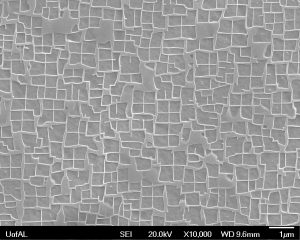
Title: Emerging Form
Submitted by Dr. John Yoder, Biological Sciences
Description: Abdominal expression of the two patterning proteins Wingless (red) and Engrailed (green) during metamorphosis of the fruitfly (Drosophila melanogaster). All cell nucleii are stained blue

Title: Single Crystal Up Close and Personal
Submitted by Rachel White, Graduate Student Metallurgical and Materials Engineering
Description: Single crystal CMSX-8, a nickel based superalloy, etched to reveal the microstructure and examined in a scanning electron microscope

Title: Into the Shell
Submitted by Dr.Alberto-Perez Huerta, Geological Sciences
Description: Cross section of a brachiopod shell, collected in Friday Harbor, Washington State (USA)
Scientists may not think of themselves as artists, but there are times when science and research activities lead to exceptionally beautiful visual images. This spring Rodgers Library sponsored “Sharing the Beauty of Science” a contest where we invited faculty, graduate and undergraduate students from Science, Engineering and Nursing to share with us the beauty of science by submitting up two images per individual. Our top three winners come from the departments of Biological Sciences, Geological Sciences, and Metallurgical and Materials Engineering.
Congratulations to all the winners for generating such high quality images and for sharing with us the beauty of their work!
Enjoy!